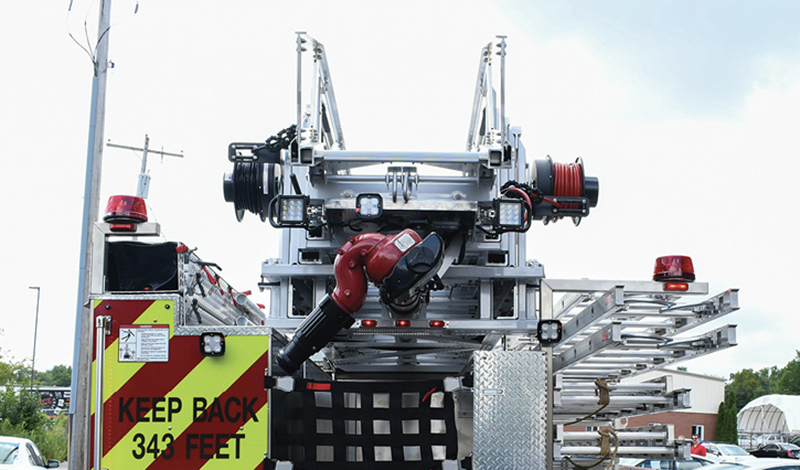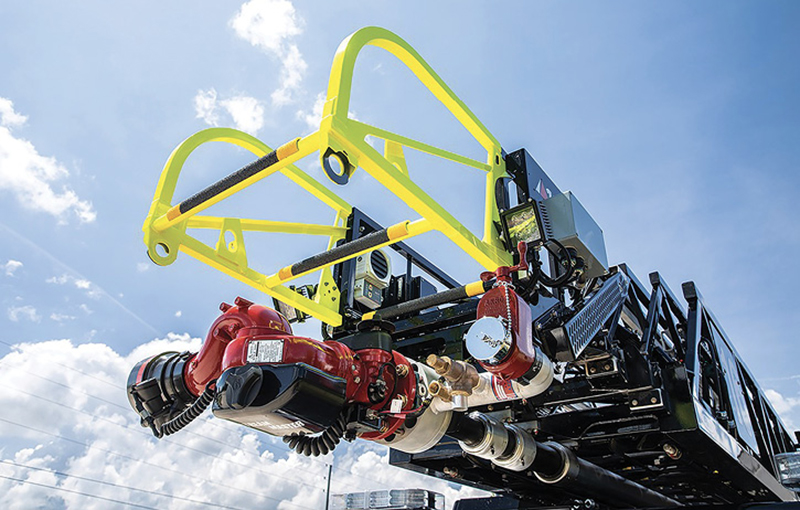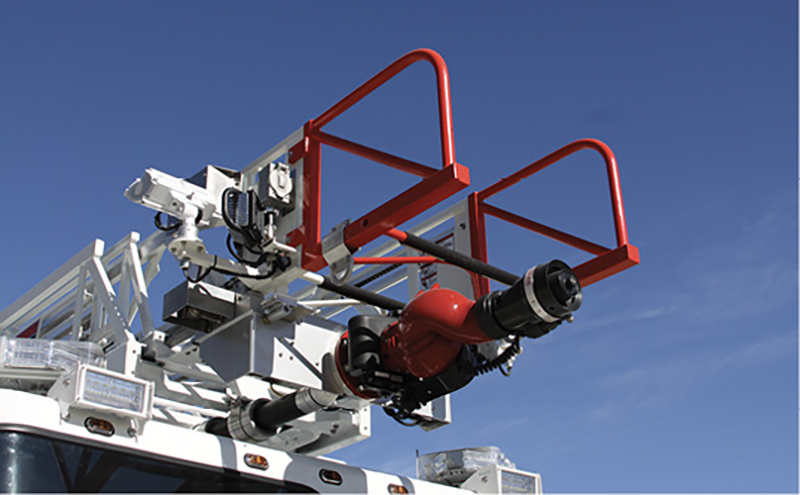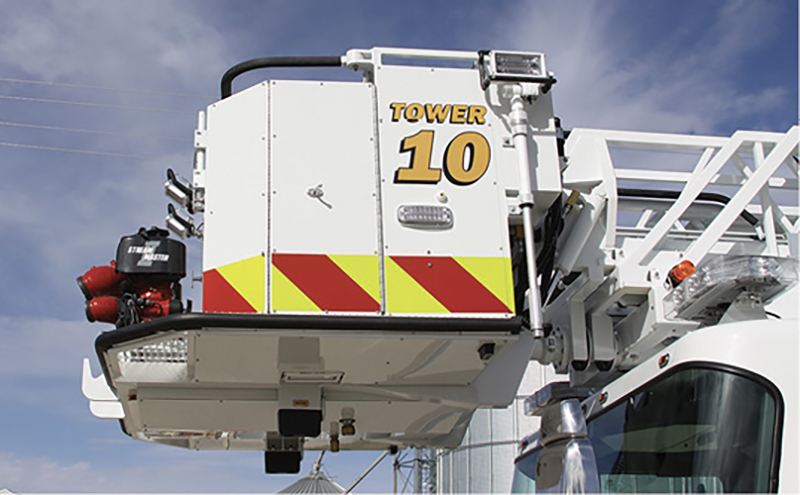When buying a new aerial ladder or platform, many fire departments are choosing to add specialized equipment at the tip, making it safer for firefighters to egress to a roof, make a rescue, or set up for a rappel or Stokes basket operation.
Manufacturers are offering these and other types of special equipment to make their aerials as functional as possible.
Justin Howell, southeast region sales territory manager for Sutphen Corp., says the typical equipment Sutphen puts at the tip of its straight stick aerials includes a 2½-inch waterway with a swing handle ball valve, a monitor and its wireless controls, a scene light with an off/on switch, and a pike pole and folding ladder nesting inside the Sutphen four-sided box boom.
“With our SPH mid-mount aerial platform, there’s a lot more working area, so we have great versatility of what we can put out there,” Howell says. A typical group of equipment on such a platform might include two electric or manual monitors, a 2½-inch gated valve, a built-in Stokes arm and parapet ladder fixture, a tray for a 50-foot hose donut roll, an enclosed box for climbing ropes, an ax and married set of irons attachments, a chain saw sleeve, various options for scene lights, telescopic lights at the back of the platform that can serve as an elevated light tower, a thermal imaging unit, and a pike pole and folding ladder on the fly section.
“We built an aerial for a Tennessee fire department that has a wireless camera on the bucket with a monitor at the base section, along with proximity sensors around the platform and a sensor that hangs below it to alert when the bucket is getting close to a charged power line,” Howell says.
- Lighting and Special Equipment at the Tips of Ladders, Platforms
- Technology Helps Firefighters in Use of Aerial Apparatus
Justin Rice, North American aerial sales manager for E-ONE, says some city departments, notably the Boston (MA) and the Cincinnati (OH) Fire Departments, like to keep their ladder tips as uncluttered as possible to allow precise placement in a window. “For instance, Boston’s ladder tips have a clamp-on ax bracket, an LED scene light, and an intercom,” Rice says, “and Cincinnati is similar. The Phoenix (AZ) Fire Department adds an extra light and a saw scabbard, while other departments choose to have lifting eyes, additional lighting, and a TFT Valve Under Monitor (VUM).”
For platforms, Rice says the philosophy among Northeastern U.S. fire departments seems to be “less is more.” He says he sees a lot of those departments using manual tiller bar monitors on platforms, generally with consoles at the front of the bucket. “But, there are some departments that want the console in a corner, so they free up the front space for a trash line, soft scabbard, and more lighting like we did for the Oakland (NJ) Fire Department,” he notes. “For the Tallahassee (FL) Fire Department’s platform, we put on a color optical camera, a saw scabbard, wireless controls, lifting eyes, and multiple light bars on the bottom of the bucket.”
Robert Triche, aerial sales manager for Ferrara Fire Apparatus, points out that a year ago, Ferrara was being asked for a halligan and ax fixed to the tip of its ladders but that recently many departments are removing those tools and cleaning up their ladder tips. “But, we have put thermal imaging on about a half dozen municipal aerial ladders this past year, which means the department doesn’t have to put a firefighter at the tip but gets the same outcome,” he says.
Platforms have a lot more space for equipment, Triche says, with Ferrara’s standard equipment being axes and hooks in the basket, a parapet ladder fixture, and a rappelling arm that doubles as a Stokes landing area. “We’re also putting a lot of VUMs on platforms and also holders to mount saws and battery chargers for battery operated circular and chain saws.”
Tim Burkhart, aerial account manager for Spartan Emergency Response, notes that the company doesn’t derate the tip load for any of the standard tools it puts at an aerial’s tip, such as pike poles, axes, optional scabbards, and a rappelling arm and pulleys for rope rescue.
Chuck Glagola, Spartan Emergency Response’s regional account manager, says that either pickhead or flathead axes are usually fixed to the fly section of an aerial ladder. “Smeal aerials offer an FRC 12-volt LED light at the tip and 110-volt LED lights farther back, some with swivel brackets so they are out of the way when stowed,” Glagola says. “The 30-degree up nozzle is a popular option on straight sticks.”
Glagola says, “It’s amazing what departments put in their baskets. We’ve done pike poles, axes, halligans, hose rolls, chain saws, vent saws, storage boxes, a 5-foot preconnected pony line, parapet ladder fixtures, rappelling arms and eyelets, Stokes basket fixtures, VUMs, and 12-volt lighting.”

1 This view of a Sutphen SPH 100 aerial platform shows a wide array of equipment that can be carried in and on the bucket. (Photos 1-2 courtesy of Sutphen Corp.)

2 The business end of a Sutphen mid-mount aerial ladder.

3 A Spartan Emergency Response aerial ladder with an exceptionally clean tip flows water during a training exercise. (Photos 3-4 courtesy of Spartan Emergency Response.)

4 The bucket face on Spartan ER’s aerial platform built for the Charlotte (NC) Fire Department.
Jason Behler, aerial sales application engineer for KME, says standard items on straight sticks include breathing air, a chain saw scabbard, and an indicator light for finding the tip in smoky conditions. “We’ve also put high-definition optical cameras and thermal imaging cameras at the tips of ladders,” he points out. “For the Westfield (IN) Fire Department, we installed a ladder tip positioning laser that is aimed from the bottom of the fly section. If they are trying to reach a second story or soffet, it shoots the beam up to get the position for the tip.”
Compared with a ladder tip, Behler notes there is a lot more equipment choice available on platforms because of the greater area. “We recently built a truck with a thermal imaging camera on the platform that displayed at the turntable control screen and on the officer’s cab monitor,” he says. “Equipment mounting of irons and pike poles on the outside of the bucket is becoming popular so the tools are easy to reach when the firefighters transition off the platform. And proximity sensors and various lighting options also are popular additions.”

5 The equipment at the tip of a KME 123-foot rear-mount aerial ladder. (Photos 5-6 courtesy of KME.)

6 The bucket on this KME 102-foot mid-mount aerial ladder platform is shown with a Stokes basket fixture along with other equipment.

7 Pierce Manufacturing allows for 150 pounds of tip options beyond the NFPA-required standard equipment. (Photos 7-8 courtesy of Pierce Manufacturing Inc.)

8 The platform on this Pierce mid-mount aerial ladder platform carries a Pierce Lyfe fitting that includes a Stokes attachment, rappelling eye, and parapet ladder fixture.

9 This clean ladder tip is on a Toyne rear-mount aerial ladder. (Photos 9-10 courtesy of Toyne.)

10 The bucket on this aerial platform Toyne built for the North Sioux City (SD) Fire Department has dual monitors, LED lighting at the front, and LED telescopic lights at the back.
Jenny Bloemer, senior manager of business development for aerial products at Pierce Manufacturing Inc., says standard equipment at a ladder’s tip includes an intercom, a minimum of one light, a monitor, and a nozzle—all National Fire Protection Association requirements. “Pierce allows for 150 pounds of tip options above that base configuration,” Bloemer says. “That could include an outlet for a preconnect, a roof ladder, axes and pike poles on the fly section, AC or DC outlets at the tip, a Stokes basket on the base section, remote tip controls, additional lighting, a screw plate for stacked tips, breathing air and a mask box, thermal imaging and optical cameras, and rung lighting.”
Pierce’s standard configuration on aerial platforms is one monitor and nozzle, two discharges, an intercom, two lights, breathing air with two outlets, and a mask box, Bloemer says. Options on platforms include hose and other storage boxes, a second monitor and nozzle, additional lighting, a Lyfe® fitting (Stokes attachment, rappelling eye, and parapet ladder fixture), removable winch brackets, and thermal imaging and optical cameras.
Mike Watts, national sales manager for Toyne, says that for aerial ladders, his company offers a bolt-on egress tip that allows for quick repair if it is damaged, scene lighting, an electrical outlet, rescue eyelets, a waterway attached to the fly section or the mid-section, and a 30 degree above parallel nozzle.
ALAN M. PETRILLO is a Tucson, Arizona-based journalist, the author of three novels and five nonfiction books, and a member of the Fire Apparatus & Emergency Equipment Editorial Advisory Board. He served 22 years with the Verdoy (NY) Fire Department, including in the position of chief.

